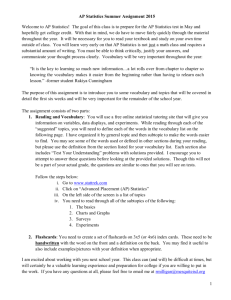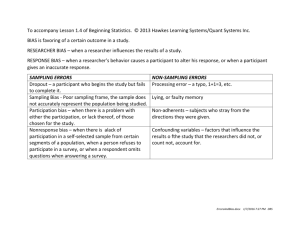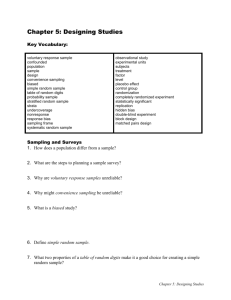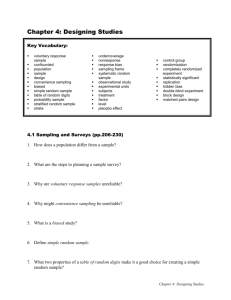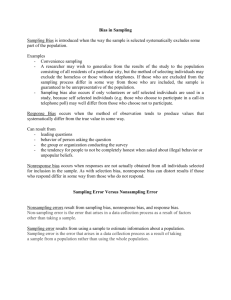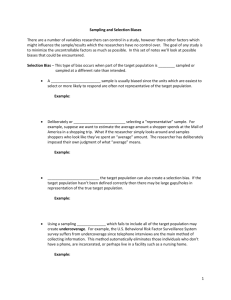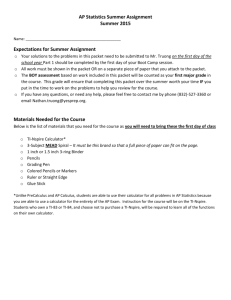Design summary
advertisement
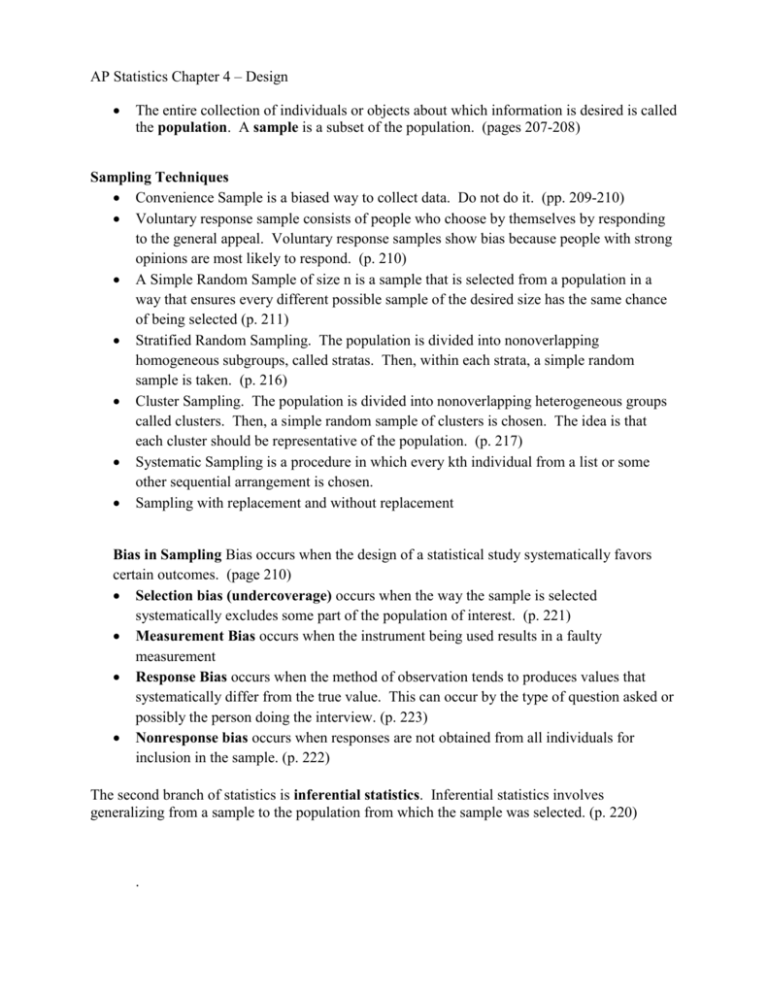
AP Statistics Chapter 4 – Design The entire collection of individuals or objects about which information is desired is called the population. A sample is a subset of the population. (pages 207-208) Sampling Techniques Convenience Sample is a biased way to collect data. Do not do it. (pp. 209-210) Voluntary response sample consists of people who choose by themselves by responding to the general appeal. Voluntary response samples show bias because people with strong opinions are most likely to respond. (p. 210) A Simple Random Sample of size n is a sample that is selected from a population in a way that ensures every different possible sample of the desired size has the same chance of being selected (p. 211) Stratified Random Sampling. The population is divided into nonoverlapping homogeneous subgroups, called stratas. Then, within each strata, a simple random sample is taken. (p. 216) Cluster Sampling. The population is divided into nonoverlapping heterogeneous groups called clusters. Then, a simple random sample of clusters is chosen. The idea is that each cluster should be representative of the population. (p. 217) Systematic Sampling is a procedure in which every kth individual from a list or some other sequential arrangement is chosen. Sampling with replacement and without replacement Bias in Sampling Bias occurs when the design of a statistical study systematically favors certain outcomes. (page 210) Selection bias (undercoverage) occurs when the way the sample is selected systematically excludes some part of the population of interest. (p. 221) Measurement Bias occurs when the instrument being used results in a faulty measurement Response Bias occurs when the method of observation tends to produces values that systematically differ from the true value. This can occur by the type of question asked or possibly the person doing the interview. (p. 223) Nonresponse bias occurs when responses are not obtained from all individuals for inclusion in the sample. (p. 222) The second branch of statistics is inferential statistics. Inferential statistics involves generalizing from a sample to the population from which the sample was selected. (p. 220) . Observational versus Experiments (p. 231) Lurking variable is a variable that is not among the explanatory or response variables in a study but may influence the response variable. (p. 232) Confounding variable is one that is related to both group membership and the response variable of interest in a research study. (pp. 232-33) Experimental units are the smallest collection of individuals to which treatments are applied. When the units are humans, they are often called subjects. (p. 233) A specific condition applied to the individuals in an experiment is called a treatment. Experiments: Experimental Design (pp. 237-241) o Randomization o Blocking: Once the sample has been chosen, create blocks that are similar. Then treatments are then tried in each block. Individuals or objects in each block are randomly assigned to each treatment. (pp. 246-249) o Direct Control: Hold extraneous factors constant using appropriate design techniques. o Replication: Sample size is large enough. When describing a design on an AP Problem, always include randomization, describe the treatments, and state you would measure and compare the response (put in context) variable. READ EXAMPLE ON PAGE 239 & 248 A control group is a group that does not receive treatment that is used to provide a baseline for comparison to the treatment group. (p. 239) A placebo is something that is identical (in appearance, taste, feel, etc.) to the treatment received by the treatment group, except that it contains no active ingredient. (p. 243) A placebo group is not always appropriate. Often one test old treatment versus new treatment. A Single blind experiment is one in which the subject does not know which treatment they are receiving. A Single blind experiment can be one in which the person measuring the response does not know which treatment the individual received. A Double blind experiment is one in which neither the subjects nor the individuals who measure the response know which treatment was received. (p. 244) Matched Pairs (type of blocking on pages 249-250) When can you generalize to the population? READ PAGE 262 When can you get cause and effect? READ PAGE 262 Section summaries on pages 225, 252

